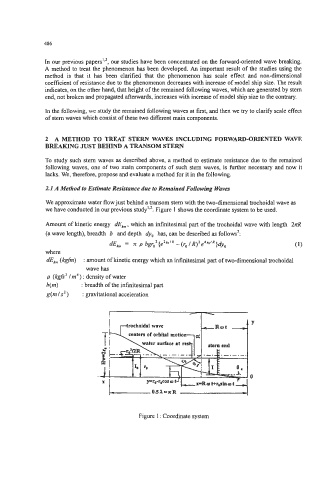Page 511 - Practical Design Ships and Floating Structures
P. 511
486
In our previous papers12, our studies have been concentrated on the forward-oriented wave breaking.
A method to treat the phenomenon has been developed. An important result of the studies using the
method is that it has been clarified that the phenomenon has scale effect and non-dimensional
coefficient of resistance due to the phenomenon decreases with increase of model ship size. The result
indicates, on the other hand, that height of the remained following waves, which are generated by stem
end, not broken and propagated afterwards, increases with increase of model ship size to the contrary.
In the following, we study the remained following waves at first, and then we try to clarify scale effect
of stem waves which consist of these two different main components.
2 A METHOD TO TREAT STERN WAVES INCLUDING FORWARD-ORIENTED WAVE
BREAKING JUST BEHIND A TRANSOM STERN
To study such stem waves as described above, a method to estimate resistance due to the remained
following waves, one of two main components of such stem waves, is further necessary and now it
lacks. We, therefore, propose and evaluate a method for it in the following.
2.1 A Method to Estimate Resistance due to Remained FoIIowing Waves
We approximate water flow just behind a transom stem with the two-dimensional trochoidal wave as
we have conducted in our previous study’.’. Figure 1 shows the coordinate system to be used.
Amount of kinetic energy dE,,, which an infinitesimal part of the trochoidal wave with length 2nR
(a wave length), breadth b and depth dy, has, can be described as follows7:
dE,, = 7c p bgro2{e2Yo’R -(r0 /R)2e4yo‘R}dyo (1)
where
dE,, (kgfm) : amount of kinetic energy which an infinitesimal part of two-dimensional trochoidal
wave has
p (kgfs2 /m4): density ofwater
b(m) : breadth of the infinitesimal part
g(m / s2 : gravitational acceleration
Y
ten of orbital motion
0
Figure 1 : Coordinate system

